My guess is none of you experienced a long time hunger. But probably most of you are familiar with the feeling of skipping 2 or 3 meals.
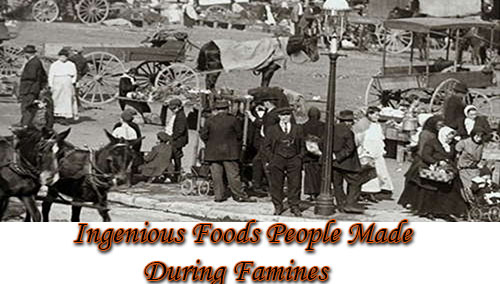
Not a very pleasant one. During that time did you experience fatigue or dizziness? These are the first general symptoms of malnutrition.
An average man cannot survive without food for more than 8 weeks. A famine may last for years like the Tempo Famine in Japan (4 years). Not many of us have such large stockpiles. And it’s not even enough to stockpile food in order to properly prepare since you may develop malnutrition if you lack a single vitamin in your diet.
During the Norway Famine
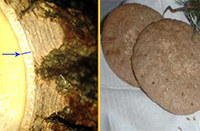 Bark Bread – is a bread made by adding inner bark (carries organic nutrients) to the flour as an extender to make it last longer, bake more breads and still keep them nutritious. In fact bark meal contains more zinc, magnesium and iron then is found in rye and wheat and it is full of fiber.
Bark Bread – is a bread made by adding inner bark (carries organic nutrients) to the flour as an extender to make it last longer, bake more breads and still keep them nutritious. In fact bark meal contains more zinc, magnesium and iron then is found in rye and wheat and it is full of fiber.
It was widely used during Norway famine, the Finland Famine and it was commonly eaten by our ancestors.
The bark component was usually made from trees like elm, ash, aspen, rowan, birch, pine and moss.
The inner bark is the only part of a tree trunk that is actually edible, the remaining bark and wood is made up of cellulose which no man can digest. The dried and ground inner bark was added: about 1/3rd “bark flour” to the remaining grain flour.
The bark, however, adds a rather bitter taste to the bread, and gives particularly white bread a grey-green hue. Though bark today is sometimes added to pastry as a culinary curiosity, bark bread is considered an emergency food, and as is common with such food, phased out as soon as the availability of grain improves and people forget about it.
During the Famines of Russia
During famines in Russia, nettle and orache were used to make breads or soups (But you can also make polenta, pesto and purée). Chamiso and Shadscale (two species of orache) were also commonly eaten by Native Americans. Both rich in Vitamin E (much needed in a food crisis).
Nettle has a flavor similar to spinach (prepared in exactly the same way) when cooked and is rich in vitamins A, C, iron, potassium, manganese, and calcium. Soaking stinging nettles in water or cooking will remove the stinging chemicals from the plant.
Some breads were made out of orache and bran at the Siege of Leningrad, using machine oil – the only oil still available. (see picture) The city authorities provided the population with foodstuffs salvaged from industry. They made hard cakes of pressed seed hulls left over from processing of oil from sunflower, cotton, hemp or linseed. These seed cakes sustained many lives in Leningrad.
In France, Germany and Belgium During the Famine of WWI and WWII

Steckrübeneintopf
Rutabagas were widely used as a food of last resort in Europe during the famine of World War I and World War II. The roots are prepared for human food in a variety of ways, and theleaves can be eaten as a leaf vegetable. Especially the French and the Germans boiled rutabaga making a stew.
During the Irish Famine
It is also called “The Potato Famine” since it was caused by a devastating potato disease (blight).
Corn meal sold for a few times more pennies a pound, so the men were unable to earn enough money to adequately feed themselves let alone their families as food prices continued to climb.
As a result, children sometimes went unfed so that parents could stay healthy enough to keep working for the desperately needed cash. Many of the workers, poorly clothed, malnourished and weakened by fever, fainted or even dropped dead on the spot.
As the Famine worsened, and looters became commonplace and the British continually sent in more troops instead of food.
The Irish in the countryside began to live off:
– Wild blackberries
– Ate Nettles
– Turnips
– Several species of edible kelp, including dulse and Irish moss
– Old cabbage leaves
– Edible seaweed
– Fungi
– Shellfish
– Roots
– Frogs
– Roadside weeds
– and even green grass
Finally, Government-sponsored soup kitchens were established throughout the countryside and began dispensing a nutritious food called Stirabout.
 ‘Stirabout,’ si a substantial porridge made from two-thirds Indian corn meal and one-third rice, cooked with water. By the summer, three million Irish were being kept alive on a pound of stirabout and a four-ounce slice of bread each day.
‘Stirabout,’ si a substantial porridge made from two-thirds Indian corn meal and one-third rice, cooked with water. By the summer, three million Irish were being kept alive on a pound of stirabout and a four-ounce slice of bread each day.
Seed potatoes, many having been eaten, had been in short supply. Planters had either been involved in the public works projects or had been too ill to dig the next year. Others were simply discouraged, knowing that whatever they grew would be seized by landowners, agents or middlemen as back payment for rent.
In a food crisis you can buy EVERYTHING with food.
 During the Mormon Famine in Western United States
During the Mormon Famine in Western United States
Sego lily bulbs were eaten by the Mormon pioneers when their food crops failed. The flower is endemic to the Western United States and it is actually the state flower of Utah. The bulbs of the flower were roasted, boiled or made into porridge. The plant was also eaten by Native Americans.
During the Dutch Famine
During the WWII the northern provinces became isolated from the liberated parts of Europe. Food stocks ran out, as did fuel stocks. Then a harsh winter began.
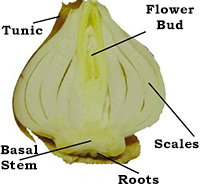 Due to the war situation, tulip growers have not planted tulip bulbs that year; great amounts of tulip bulbs were stocked on farms throughout the country. During the famine authorities decided to use these stocks as food for the starving populations. The tulip bulbs were nutritious and relatively easy to cook.
Due to the war situation, tulip growers have not planted tulip bulbs that year; great amounts of tulip bulbs were stocked on farms throughout the country. During the famine authorities decided to use these stocks as food for the starving populations. The tulip bulbs were nutritious and relatively easy to cook.
Here’s an account about how they prepared the bulbs (of one of the survivors – Father Leo):
“The skin of the bulb is removed, pretty much like an onion, and so is the center, because that is poisonous. Then it is dried and baked in the oven. My mother or older sisters would grind the bulbs to a meal-like consistency. Then they would mix the meal with water and salt, shape it like a meatloaf, and bake it. I can still remember the taste of it: like wet sawdust…We still shared tulip bulbs and sugar beets with those with hand-drawn carts who continued to go from door to door. I think seeing my mother still give to the hungry at this time, even though we had very little, made me want to be a missionary.” (Source)
They also boiled and ate Sugar beets. These are high in fiber, manganese, and is a decent source of vitamin C, potassium and magnesium. The greens, though, are really the nutritional powerhouse of the plant. They are super high in fiber, vitamin A, vitamin C, vitamin K, riboflavin, calcium, iron, magnesium, copper, manganese.
During most famines
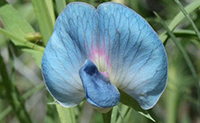 Grass pea is a particularly important crop in areas that are prone to drought and famine, and is thought of as an ‘insurance crop’ as it produces reliable yields when all other crops fail.
Grass pea is a particularly important crop in areas that are prone to drought and famine, and is thought of as an ‘insurance crop’ as it produces reliable yields when all other crops fail.
Well that’s something people eat when there’s nothing else to eat, because eating grass pea may cause a disease that basically paralyzes the lower limbs. The disease occurs only when the seeds are consumed as a primary protein source for a prolonged period but safe to eat for days maybe weeks.

Grasspea Soup and Bread
When a famine occurs, that’s hell of a lot of people who end up eating this grass pea. The ratio is fairly small with about 10 out of 1000 people who get the disease.
Flour was made out of grass peas (named almorta) and they mixed it with wheat flour to eliminate the toxicity.
During Holodomor (The Ukrainian Famine)
For those faint-hearted: don’t read the next paragraph. You’ll find 3 real recollections of survivors from one of the most horrific famines. I wanted to include this in the article so people would better understand why and what do we prep for. And why having a food stockpile is an insurance you’ll not end up in this situation.
Olexandra Rafalska – one of the survivors – noted:
“…I have no idea how I managed to survive and stay alive. In 1933 we tried to survive the best we could. We collected grass, goose-foot, burdocks, rotten potatoes and made pancakes, soups from putrid beans or nettles.
Collected clay from the trees and ate it, ate sparrows, pigeons, cats, dead and live dogs. When there was still cattle, it was eaten first, then – the domestic animals. Some were eating their own children, I would have never been able to eat my child. One of our neighbors came home when her husband, suffering from severe starvation ate their own baby-daughter. This woman went crazy. “ (Source)
Galina Smyrna, village Uspenka of Dniepropetrovsk region recollected:
“I remember Holodomor very well, but have no wish to recall it. There were so many people dying then. They were lying out in the streets, in the fields, floating in the flux. My uncle lived in Derevka – he died of hunger and my aunt went crazy – she ate her own child. At the time one couldn’t hear the dogs barking – they were all eaten up.” (Source)
A boy, 9 years old back then (later known as Dr M.M.):
“Mother said, ‘Save yourself, run to town.’ I turned back twice; I could not bear to leave my mother, but she begged and cried, and I finally went for good.” (Source)
Preparing for a food crisis or famine means preparing for at least one year. But famines can last up to 7 years and it can be wiser to have the means to produce your own food rather than stockpiling. One of the best ways to do that is by building a system totally independent from the environment.
And this CAN be done.
Source: www.askaprepper.com
In short, mankind managed to survive through the worse of times. Just like our forefathers used to do, The Lost Ways Book teaches you how you can survive in the worst-case scenario with the minimum resources available. It comes as a step-by-step guide accompanied by pictures and teaches you how to use basic ingredients to make super-food for your loved ones.
 Here’s just a glimpse of what you’ll find in The Lost Ways:
Here’s just a glimpse of what you’ll find in The Lost Ways:
From Ruff Simons, an old west history expert and former deputy, you’ll learn the techniques and methods used by the wise sheriffs from the frontiers to defend an entire village despite being outnumbered and outgunned by gangs of robbers and bandits, and how you can use their wisdom to defend your home against looters when you’ll be surrounded.
Native American ERIK BAINBRIDGE – who took part in the reconstruction of the native village of Kule Loklo in California, will show you how Native Americans build the subterranean roundhouse, an underground house that today will serve you as a storm shelter, a perfectly camouflaged hideout, or a bunker. It can easily shelter three to four families, so how will you feel if, when all hell breaks loose, you’ll be able to call all your loved ones and offer them guidance and shelter? Besides that, the subterranean roundhouse makes an awesome root cellar where you can keep all your food and water reserves year-round.
From Shannon Azares you’ll learn how sailors from the XVII century preserved water in their ships for months on end, even years and how you can use this method to preserve clean water for your family cost-free.
Mike Searson – who is a Firearm and Old West history expert – will show you what to do when there is no more ammo to be had, how people who wandered the West managed to hunt eight deer with six bullets, and why their supply of ammo never ran out. Remember the panic buying in the first half of 2013? That was nothing compared to what’s going to precede the collapse.
From Susan Morrow, an ex-science teacher and chemist, you’ll master “The Art of Poultice.” She says, “If you really explore the ingredients from which our forefathers made poultices, you’ll be totally surprised by the similarities with modern medicines.” Well…how would you feel in a crisis to be the only one from the group knowledgeable about this lost skill? When there are no more antibiotics, people will turn to you to save their ill children’s lives.
And believe it or not, this is not all…
Table Of Contents:
Making Your Own Beverages: Beer to Stronger Stuff
Ginger Beer: Making Soda the Old Fashioned Way
How North American Indians and Early Pioneers Made Pemmican
Spycraft: Military Correspondence During The 1700’s to 1900’s
Wild West Guns for SHTF and a Guide to Rolling Your Own Ammo
How Our Forefathers Built Their Sawmills, Grain Mills,and Stamping Mills
How Our Ancestors Made Herbal Poultice to Heal Their Wounds
What Our Ancestors Were Foraging For? or How to Wildcraft Your Table
How Our Ancestors Navigated Without Using a GPS System
How Our Forefathers Made Knives
How Our Forefathers Made Snow shoes for Survival
How North California Native Americans Built Their Semi-subterranean Roundhouses
Our Ancestors’Guide to Root Cellars
Good Old Fashioned Cooking on an Open Flame
Learning from Our Ancestors How to Preserve Water
Learning from Our Ancestors How to Take Care of Our Hygiene When There Isn’t Anything to Buy
How and Why I Prefer to Make Soap with Modern Ingredients
Temporarily Installing a Wood-Burning Stove during Emergencies
Making Traditional and Survival Bark Bread…….
Trapping in Winter for Beaver and Muskrat Just like Our Forefathers Did
How to Make a Smokehouse and Smoke Fish
Survival Lessons From The Donner Party
Get your paperback copy HERE
WHAT TO READ NEXT:
5 TECHNIQUES TO PRESERVE MEAT IN THE WILD YOU SHOULD PRACTICE
HOW TO MAKE YOUR OWN BACON (STEP BY STEP GUIDE)
A RETURN TO THE OLD PATHS: HOW TO MAKE PEMMICAN LIKE THE NATIVE AMERICANS
20 LOST RECIPES FROM THE PIONEERS: WHAT THEY COOKED ON THEIR JOURNEY WESTWARD
SEVEN CLASSIC GREAT DEPRESSION ERA RECIPES GRANDMA USED TO MAKE
POTTED MEAT: A LOST SKILL OF LONG TERM MEAT STORAGE
BACK TO BASICS: HOW TO MAKE AND PRESERVE LARD
THE BEST WAY TO STOCKPILE VEGETABLES OFF-GRID
OLD FASHIONED PRESERVING-GRANDPA’S RECIPE FOR CURED SMOKED HAM
HOW TO MAKE GUNPOWDER THE OLD FASHIONED WAY
SURVIVAL HERBAL RECIPES FROM OUR ANCESTORS
HOW TO PRESERVE MEAT FOR SURVIVAL LIKE OUR GRANDFATHERS
OTHER USEFUL RESOURCES:
The 3 Pioneer Survival Lessons We Should Learn
The Most Effective Home Defense Strategies
Old School Hacks for Off-Grid Living
The Medical Emergency Crash Course

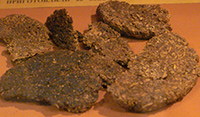
they add tree bark to cheese right now
Trouble is, most arrogant, or just brain dead Americans believe that it (can’t) happen here because of the abundance of food at the grocery stores! Really dangerous mind set, because it (will) happen here as well, so stock up NOW!!
BarkBread… I bet the splinters are Hell! 🙂
It’s appropriate time to make some plans for the longer term and it is time to be happy.
I have learn this submit and if I could I
desire to recommend you few fascinating issues or suggestions.
Perhaps you can write subsequent articles relating to this article.
I wish to read even more issues about it!
Generally I don’t learn article on blogs, however I would like to say that this write-up very forced me
to check out and do it! Your writing style has been surprised me.
Thank you, quite nice article.